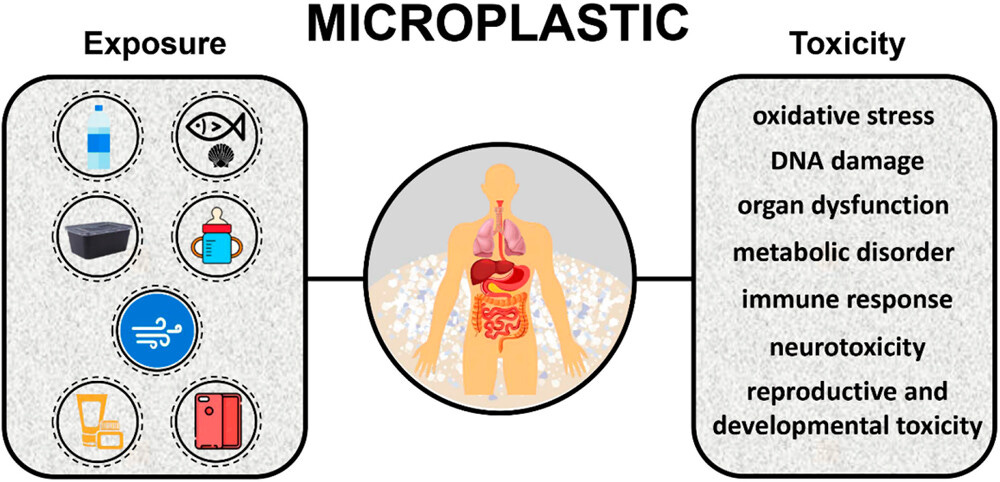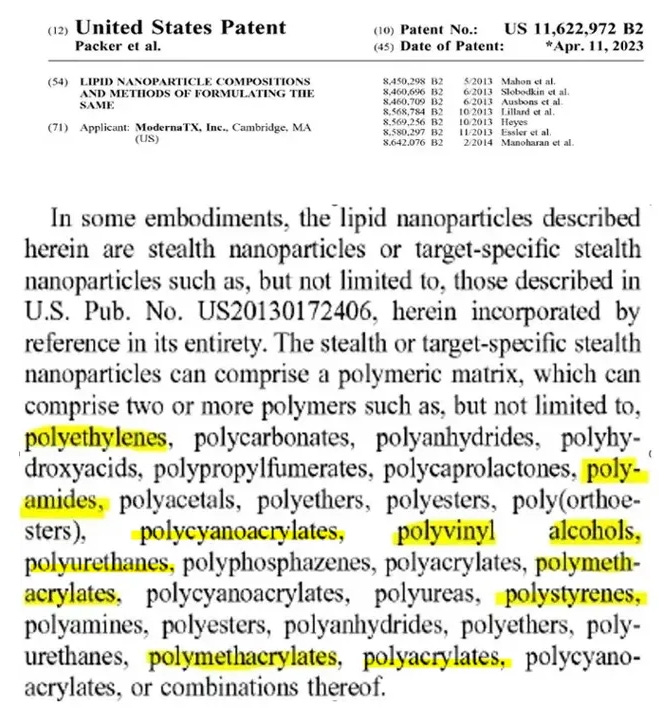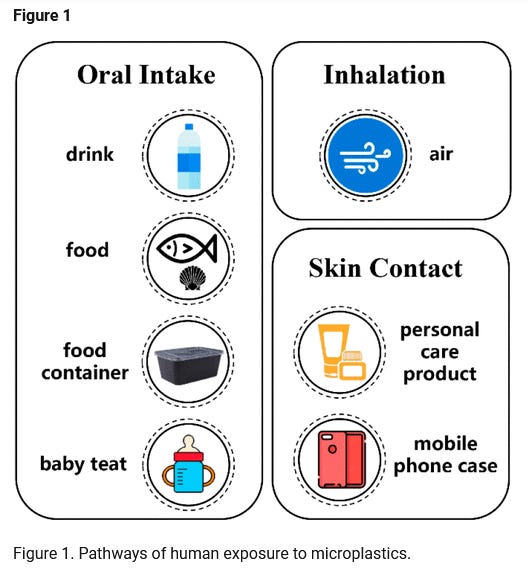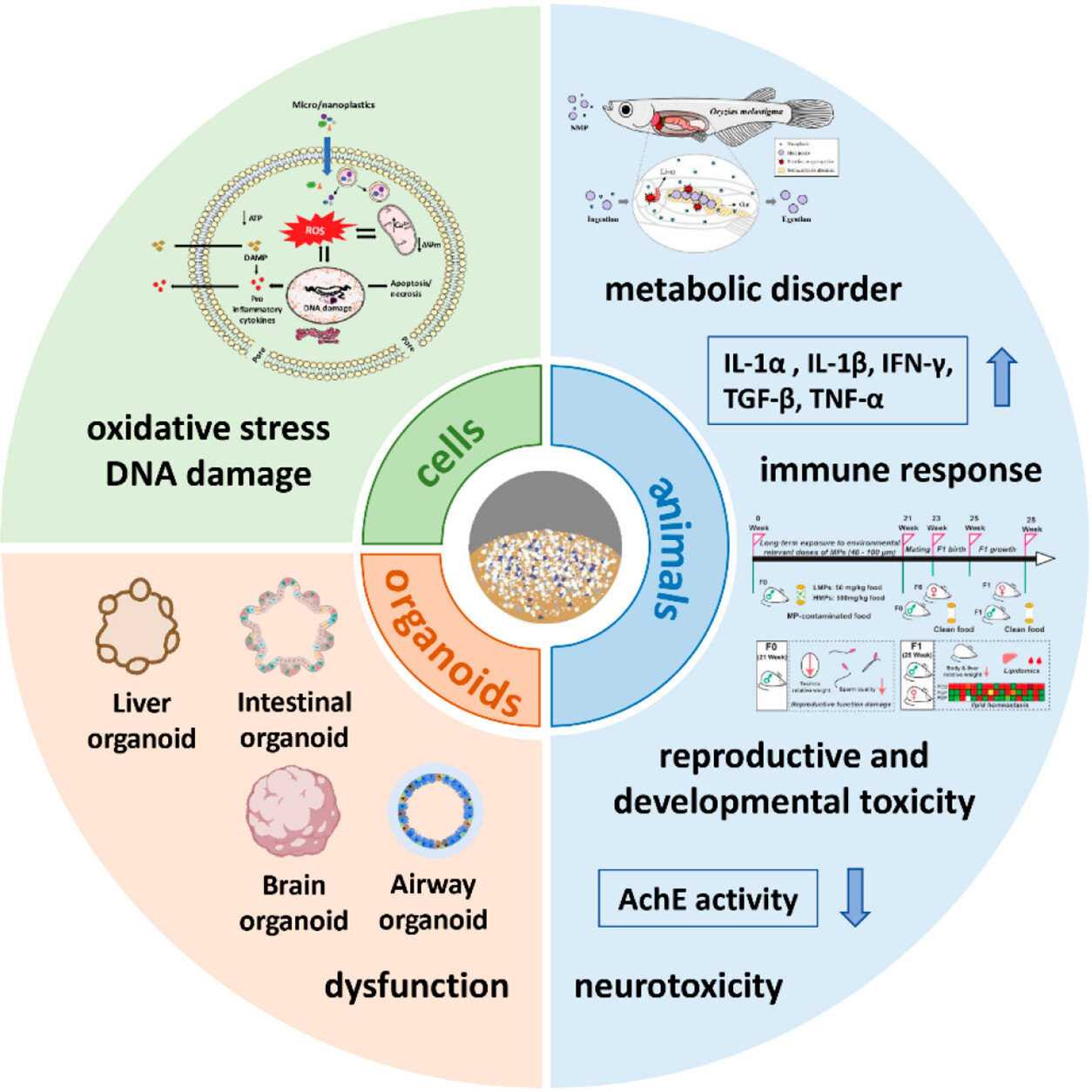Health Impact of Microplastics: A Review of Environmental Distribution, Human Exposure, Toxic Effects And Relationship To Chronic Diseases
I am a member of the American Chemical Society. Aside from the nanotechnology literature
by Ana Maria Mihalcea, MD, PhD
I am a member of the American Chemical Society. Aside from the nanotechnology literature, ACS has been consistently publishing excellent scientific papers on the findings of microplastics in human tissues. This review article is eye opening, for the overlap of the microplastics toxicity to also vaccine injury that uses polymer plastics stealth nanoparticles as well as the geoengineering of polymers that people inhale and also contaminate our biosphere.
The bottom line is that these chemicals are toxic for humanity. Why are they allowed in medications and vaccines? I believe that the acclerated aging process we have been seeing is caused by the enormous burden of self replicating nano and microplastic polymers that are in the blood and penetrate to every organ system. The self assembly nanoparticles are what create the polymers in the blood, it is not just the microplastic exposure from environmental sources as I have shown before.
Please note that all of these plastics are also stealth nanoparticles in the Moderna patent: ___________________________________________________________________________
A recent review indicates that microplastics are transported to the whole body through blood circulation, and the existence of microplastics are found in 15 human biological components, such as the spleen, liver, colon, lung, feces, placenta, breastmilk, etc. (58) The organs with high content are the colon (28.1 particles/g) and liver (4.6 particles/g). The main types of microplastics detected include PE, PET, PP, PS, PVC, and PC.
(Polyethylene, Polyelthylene Terephtalate, Polypropylene, Polystyrene, Polyvinyl Chloride, Polycarbonate)
__________________________________________________________________________
Video: COVID19 unvaccinated blood. Micellar construction site filled with nanorobots building a mesogen polymer microchip. Magnficiation 2000x.
Please read this interesting and eye opening article:
Microplastics are ubiquitous in the global environment. As a typical emerging pollutant, its potential health hazards have been widely concerning. In this brief paper, we introduce the source, identification, toxicity, and health hazard of microplastics in the human. The literature review shows that microplastics are frequently detected in environmental and human samples. Humans are potentially exposed to microplastics through oral intake, inhalation, and skin contact. We summarize the toxic effects of microplastics in experimental models like cells, organoids, and animals. These effects consist of oxidative stress, DNA damage, organ dysfunction, metabolic disorder, immune response, neurotoxicity, as well as reproductive and developmental toxicity. In addition, the epidemiological evidence suggests that a variety of chronic diseases may be related to microplastics exposure. Finally, we put forward the gaps in toxicity research of microplastics and their future development directions. This review will be helpful to the understanding of the exposure risk and potential health hazards of microplastics.
2.1. Oral Intake
Microplastics exist in our daily necessities like drinking water, bottled water, seafood, salt, sugar, tea bags, milk, and so on. (21−29) Europeans are exposed to about 11,000 particles/person/year of microplastics due to shellfish consumption, (30) and according to food consumption, the intake of plastic particles in human body is 39,000–52,000 particles/person/year. (31) Microplastics may also have been widely distributed in soil, especially in agricultural systems. (20) They (especially with negative charge) can get into the water transport system of plants, and then move to the roots, stems, leaves, and fruits. (32,33) Once microplastics enter agricultural systems through sewage sludge, (34) compost, (35) and plastic mulching, (36) they will cause food pollution, which may increase the risk of human exposure.
Take-out food containers made of common polymer materials (PP, PS, PE, PET) are used widely, from which microplastics are found. (37,38) It is estimated that people who order take-out food 4–7 times weekly may intake 12–203 pieces of microplastics through containers. (38) In addition, research demonstrates that the surface of silicone rubber baby teats degrades when they are sterilized by steam, during which microplastic particles are released into the environment. (39) It is estimated that the total number of microplastic particles entering the baby’s body during one year of normal bottle feeding reaches about 0.66 million.
2.2. Inhalation
Microplastics in the air are mainly PE, PS, and PET particles and fibers with size ranges of 10–8000 μm. (40) The largest source of microplastics (84%) in the atmosphere comes from the road. (41) It is reported that the median concentration of microplastic fibers is 5.4 fibers/m3 in the outdoor air and 0.9 fibers/m3 in the indoor air in Paris. (42) The average concentration of microplastics is 1.42 particles/m3 in the outdoor air in Shanghai, and the size range is 23–5000 μm. (43) It is estimated that annual microplastics consumption ranges from 74,000 and 121,000 particles when both oral intake and inhalation are considered. (31) Amato-Lourenço et al. detected microplastic particles smaller than 5.5 μm and microplastic fibers with the size of 8.12–16.8 μm in human lungs, whose main components are PE and PP. (44) The size of microplastics detected in lung tissue is smaller than that in the atmosphere. This further confirms that humans can be exposed to microplastics by inhalation and prompts attention to the potential harm to the human body.
2.3. Skin Contact
Microplastics are usually considered not to pass through the skin barrier, (45) but they can still increase exposure risk by depositing on the skin. (46) For example, the use of consumer products containing microplastics (such as face cream and facial cleanser) will increase the exposure risk of PE. (47) The protective mobile phone cases (PMPCs) can generate microplastics during use, which are transferred to human hands. (48) When children crawl or play, they may come into contact with microplastics on the ground. During the dermal exposure of microplastics, some typical plastic additives, including brominated flame retardants (BFRs), bisphenols (BPs), triclosan (TCS), and phthalates, may be absorbed. (49)
3. Detection of Microplastics in Organisms and Human
Microplastics are found in animals. They pose a great threat to aquatic organisms, like fish and marine mussels. Microplastic fibers are the most frequent microplastic type ingested. (50) All fishes in the Haizhou Bay have microplastics with the highest abundance of 22.21 ± 1.70 items/individual. (26) Mussels in the French Atlantic coast and the coastal waters of the U.K. both have microplastics. (27,51) For wild coastal animals, microplastics are found in their intestine, stomach, liver, and muscle. (52) PET is also detected in the feces of pets, such as cats (<2300–340,000 ng/g) and dogs (7700–190,000 ng/g). (53) Microplastics also exist in plants and algae. Liu et al. carried out a hydroponic experiment, which they confirmed using confocal laser scanning microscopy that microplastics can transfer from roots to the aboveground parts of rice seedlings. (54) Yan et al. reports that microplastics are internalized in the vacuoles of algal cells. (55) It is noteworthy that the phenomenon of biological endocytosis of microplastics can be utilized to remove microplastics from the environment. Manzi et al. summarizes the algal species that have been used to remove microplastics from the aquatic environment and highlights the mechanism of microplastics biodegradation. (56)
It is generally believed that after entering the human body, microplastics will be excreted out through the gastrointestinal tract and biliary tract. However, researchers detect the existence of microplastics in human blood. (57) People begin to reconsider the harm of microplastics to human health. The intake, distribution, accumulation, and metabolism of microplastics in the human body are attracting more and more attention. Understanding the concentration of microplastics in the human body is an important prerequisite for exploring their potential harmful effects. A recent review indicates that microplastics are transported to the whole body through blood circulation, and the existence of microplastics are found in 15 human biological components, such as the spleen, liver, colon, lung, feces, placenta, breastmilk, etc. (58) The organs with high content are the colon (28.1 particles/g) and liver (4.6 particles/g). The main types of microplastics detected include PE, PET, PP, PS, PVC, and PC.
Pregnant women and infants are sensitive people exposed to microplastics. (59) The concentration of PET in infant feces (5700–82,000 ng/g, median: 36,000 ng/g) is ten times higher than that in adults (2200–16,000 ng/g, median: 2600 ng/g), (60) indicating that the exposure level of microplastics in infants may be much higher than adults. Twelve microplastic fragments, ranging from 5 to 10 μm, are detected in human placenta by the team of Ragusa for the first time, (61) and then they first detect PVC and PP microplastics with a size of 2–12 μm in human breastmilk. (62) Since then, more studies also detect microplastics in placenta, meconium, and breastmilk. Zhu et al. detects microplastics in 17 placental samples and identifies 11 types of polymers with sizes from 20.34 to 307.29 μm. (63) Liu et al. recruits 18 pairs of mothers and infants and determines 16 types of microplastics in placenta, meconium, infant feces, breastmilk, and infant formula samples. (64) More than 74% of microplastics are 20–50 μm in size. In accordance with the DOHaD theory, adults experiencing adverse factors in the early stages of development will increase the probability of obesity, diabetes, cardiovascular disease, and other chronic diseases in adulthood. (65) The appearance of microplastics in human placenta further emphasizes that these nondegradable chemicals have potential intergenerational influence on the human body and may affect the developing fetus. Therefore, more attention should be paid to the potential impact of early exposure of infants and early development of embryos.
4. Toxic Effects of Microplastics
Microplastics producing toxic effects is a complex process and is affected by many factors including the physical and chemical properties, exposure time, additives, etc. Microplastics are not only toxic itself but also carriers for many pollutants to enter biological tissues and organs. We aim to systematically sketch their potential toxicity at the “individual-tissue-cell-subcellular” level, which will help to explore the toxicity mechanism. Due to the lack of direct research from humans, this section briefly summarizes the major effects of microplastics in present experimental models, like cells, organoids, and animals (Figure 2).
Toxic Effects in Animal Experiments
4.4.1. Metabolic Disorder
Previous animal experiments confirm that microplastics lead to the dysfunction of the liver and intestine. For instance, Kang et al. finds that microplastics induce intestinal damage of fish by two different mechanisms. (83) PS with size of 50 nm exhibits stronger oxidative stress, while PS with size of 45 μm causes significant imbalance of intestinal flora. Kim et al. reports that microplastics lead to the inhibition of digestive enzyme activity in fish through a microalgae-crustacean-small yellow croaker food chain. (84) Jin et al. also reports that intestinal barrier and metabolic function are impaired in PS exposed mice. (85) Tan et al. demonstrates that microplastics significantly reduce lipid digestion in the simulated human gastrointestinal system, and PS shows the highest inhibition. (86) The decrease of lipid digestion is independent of PS size. Lu et al. reveals that PS exposure causes the local infection and lipid accumulation in the liver of fish and disrupts the energy metabolism. (87) In addition, Deng et al. discovers that after exposure to microplastics and organophosphorus flame retardants (OPFRs), the metabolites of mice change significantly. (88) And it is noticeable that microplastics aggravate the toxicity of OPFRs, highlighting the health risks of microplastic coexposure with other pollutants.
4.4.2. Immune Response
Microplastics can induce immune response in the body. Yuan et al. reports that PE exposure activates the intestinal immune network pathway of zebrafish and produces mucosal immunoglobulin. (89) Li et al. demonstrates that the secretion of IL-1α is increased in the serum of rats exposed to PE but decreased in the Th17 and Treg cells among CD4+ cells. (90) Lim et al. observes that inhalation of PS causes the upregulated expression of the inflammatory protein (TGF-β and TNF-α) in lung tissue of rats. (91) Liu et al. finds that PS exposure significantly increases the expression of inflammation factors (TNF-α, IL-1β, and IFN-γ) in mice, and intestinal immune imbalance will significantly increase the accumulation of microplastics, producing further toxic effects. (92)
4.4.3. Neurotoxicity
Microplastics are also toxic to the neural development. Inhibition of acetylcholinesterase (AchE) activity is the most reported neurotoxic effects after the exposure of microplastics. (93) In a study of juvenile fish, the microplastics inhibit the activity of AchE, increase lipid oxidation in the brain, and change the activities of energy-related enzymes, eventually causing neurotoxicity. (94) Prüst et al. also reports that microplastics cause the abnormal behavior of nematodes, crustaceans, and fish. (93) Yang et al. discovers that PS (70 nm) can pass through the epidermis of larvae and enter into the muscle tissue. (95) It can destroy nerve fibers, decrease the activity of AchE, and exert great adverse effects on larval movement. Besides, Jin et al. reveals that after the chronic exposure to PS at environmental pollution concentrations (100 and 1,000 μg/L), the blood-brain barrier of mice is damaged, and the learning and memory dysfunctions occur. (96)
4.4.4. Reproductive and Developmental Toxicity
The effect of microplastics on reproduction is reflected in the development of germ cells and embryo quality. For example, Liu et al. finds that the PS exposure affects the development of female mouse follicles and the maturation of oocytes, reducing the quality of oocytes. (97) And Hu et al. reports that microplastics might cause adverse effects on pregnancy outcomes through immune disorders. (98) Deng et al. finds that after long-term exposure to environmentally relevant doses of PS, the sperm quality significantly decreases, which affects the fertility of male mice. (99) In addition, Park et al. shows that the number of live births per dam and the sex ratio and body weight of pups in groups treated with PE are notably altered. (100) What’s more, they suggest the IgA level as a biomarker for harmful effects following exposure on microplastics.
Go paid at the $5 a month level, and we will send you both the PDF and e-Pub versions of “Government” - The Biggest Scam in History… Exposed! and a coupon code for 10% off anything in the Government-Scam.com/Store.
Go paid at the $50 a year level, and we will send you a free paperback edition of Etienne’s book “Government” - The Biggest Scam in History… Exposed! OR a 64GB Liberator flash drive if you live in the US. If you are international, we will give you a $10 credit towards shipping if you agree to pay the remainder.
Support us at the $250 Founding Member Level and get a signed high-resolution hardcover of “Government” + Liberator flash drive + Larken Rose’s The Most Dangerous Superstition + Art of Liberty Foundation Stickers delivered anywhere in the world. Our only option for signed copies besides catching Etienne @ an event.









